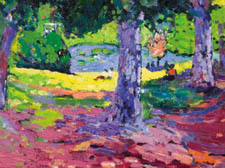|
|
 |
| |

Hampstead Ponds 1, which were part of Boswell’s love affair with London |
Painting a different shade
James Boswell, famed as a Second World War artist, went on to study landscapes nearer to home, as a new exhibition reflects.Dan Carrier reports
JAMES Boswell never meant to be known as a war artist, but after being drafted during the Second World War and posted to Iraq, he was so inspired by the scenery (and having time on his hands) he turned his sights on the world that surrounded him.
But now an exhibition at the Chambers Gallery in Spitalfields shows another side of his work. Alongside Boswell’s war pieces, his seascapes, paintings of the Thames and Highgate ponds are on display.
Born in New Zealand in 1906, Boswell moved to London in 1925 to study at the Royal College of Art. He found a studio in Fitzroy Square, which was at the heart of the Bloomsbury movement in literature and the arts.
The Omega Workshops established by the artist Roger Fry were also located in the square. Although Bloomsbury was the home of many of the movers behind the Fabian Society, the Independent Labour Party and other Socialist thinkers, it was not their influence that clarified Boswell’s leftward ideals.
His second wife, Ruth, who lives in Muswell Hill, met him after answering an advert for a personal assistant for the design journal he edited.
Boswell told her it was the gradual realisation of what life in England was like for the vast majority of people in the late 1920s and 1930s that crystalised his beliefs. “He was just appalled by the poverty around him – poverty he simply had not seen in New Zealand,” she says.
Boswell joined the Communist Party in the late 1920s and then started doing illustrations for newspapers. He worked regularly for the Daily Mirror and the Left Review, his talent finding ample copy in the ideological battles of the period.
Between 1934 and 1938 he was the Left Review’s art editor. As Ruth puts it: “…he hit out savagely at bloated capitalists, fascists, appeasers of the Nazi regime, the over-privileged and politicians.”
Boswell was called up by the army in 1939 and went to Scotland as a radiographer before being sent overseas to serve in Iraq.
“It was there he created a proper body of work,’ recalls Ruth.
“He loved the desert and did many paintings. He also began to document army life. It was a very boring existence in the desert – there was little for the soldiers to do and they had to keep themselves occupied. He gave lectures and painted his comrades.”
After being demobbed, Boswell was fed up with war, and tired of politics. From 1945 onwards he wanted to escape the fame he had attained as a political commentator with his satirical cartoons – although it was impossible to separate his strongly held beliefs with the art he produced.
In 1947 he became art editor of the magazine Lilliput and worked with other well-known names such as Ronald Searle, Gerard Hoffnung and Edward Ardizzone.
“His work was a reflection of his political beliefs,” Ruth said. “However, he had given 13 years of his life to politics and after the war, he made the decision that he just wanted to paint.”
His early inspiration was drawn from the New Zealand seascapes and this came up again and again in his later, abstract works, many which were painted in Brighton and Shoreham.
Boswell lived for many years in Parliament Hill, and regularly walked over the Heath – prompting two paintings of the Highgate ponds that are on display in the exhibition
“He had a way of looking at people and issues which helped his cartoon work. He was a satirist,” Ruth remembers.
“Most of all, James was a life-enhancer – a magnetic personality. People were attracted to him – he was funny, and lovely to be around. This shone through his works.”
|
 |
|
| |
|
 |
|

